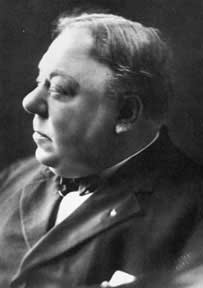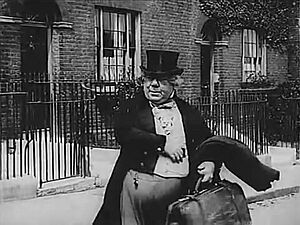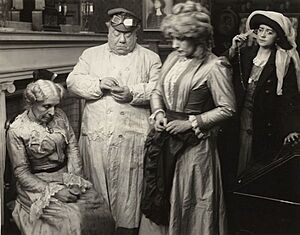John Bunny facts for kids
Quick facts for kids
John Bunny
|
|
|---|---|
 |
|
| Born | September 21, 1863 New York, New York, U.S.
|
| Died | April 26, 1915 (aged 51) New York, New York, U.S.
|
| Occupation | Actor |
| Spouse(s) |
Clara Scanlan
(m. 1890) |
| Relatives | George Bunny (brother) |
John Bunny (born September 21, 1863 – died April 26, 1915) was a famous American actor. He started his acting career on stage. Later, around 1910, he joined Vitagraph Studios and became a film actor. At Vitagraph, John Bunny made over 150 short films. Many of these were funny comedies about everyday life. He often starred with the comedian Flora Finch. John Bunny became one of the most popular actors of his time.
Contents
John Bunny's Life and Acting Career
John Bunny was born in Brooklyn, New York. He went to public schools in New York. His father was English and his mother was Irish. Before becoming an actor, he worked in a general store. When he was 20, he joined a small traveling show called a minstrel show.
From Stage to Silent Films
John Bunny acted on stage for 25 years. He worked with many theater groups that traveled around. He performed in cities like Portland, Seattle, and others on the East Coast. Eventually, he made it to Broadway, which is a very famous theater area in New York City. He was in plays like Aunt Hannah (1900) and Easy Dawson (1905). He also played the character Bottom in A Midsummer Night's Dream (1906) at the Astor Theatre. People really liked his performance in that play.
In 1915, John Bunny explained why he decided to try movies. He felt that movies were becoming very popular. This made it harder for stage actors to find work. So, he offered to work for Vitagraph Studios. At first, the studio manager thought they couldn't pay him enough. But John Bunny really wanted to act in films. He insisted on taking a lower salary.
Around 1910, he started working at Vitagraph Studios. There, he starred in more than 150 films. He often worked with the comedian Flora Finch. They made many popular comedies together. These films usually showed funny situations in homes. This was different from the wilder "slapstick" comedies of the time. Their movies became so famous they were called "Bunnygraphs" or "Bunnyfinches."
One famous "Bunnygraph" was A Cure for Pokeritis (1912). In this film, a wife wants her husband to stop gambling. She plans a fake police raid on his weekly poker game to stop him.
Why Movies Were Great for Actors
John Bunny believed that acting in movies was wonderful. He said that movie actors could work all year round. This was much better than stage actors, who might only work for 30 weeks a year. Stage work was risky. Actors might rehearse for weeks without pay. They might even buy their own costumes. But there was no guarantee the play would be a hit. If the audience didn't like it, the play could close quickly. Then, the actor would have to find a new job. Movies offered more steady work.
His Final Years
John Bunny acted in films for only five years. He passed away on April 26, 1915, at his home in Brooklyn. He died from a kidney disease called Bright's disease. He had a wife and two sons. He was buried in the Cemetery of the Evergreens in Brooklyn, New York.
Selected Films of John Bunny
John Bunny starred in many films during his career. Here are some of the movies he appeared in:
| Year | Film | Role | Notes |
|---|---|---|---|
| 1909 | Cohen's Dream | Cohen | Also known as Cohen's Dream of Coney Island |
| 1910 | Davy Jones and Captain Bragg | Captain Bragg | |
| 1911 | A Queen for a Day | Bridget McSweeney | |
| 1911 | Her Crowning Glory | Mortimer | |
| 1912 | A Cure for Pokeritis | George Brown | A famous "Bunnygraph" comedy |
| 1913 | The Pickwick Papers | Mr Pickwick | |
| 1914 | Hearts and Diamonds | Widower Tupper | |
| 1915 | The Jarrs Visit Arcadia |
See also
 In Spanish: John Bunny para niños
In Spanish: John Bunny para niños



